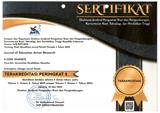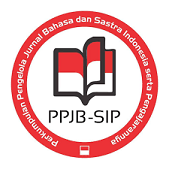TINJAUAN TERHADAP PENULISAN BERITA PADA MAJALAH SEKOLAH MENENGAH ATAS NEGERI 4 SINGARAJA TAHUN 2016
DOI:
https://doi.org/10.23887/jjpbs.v7i2.15119Abstract
Penelitian ini dilakukan di SMA Negeri 4 Singaraja. Tujuan penelitian ini ialah untuk mendeskripsikan (1) kualitas berita yang dimuat pada Majalah Kharisma SMA Negeri 4 Singaraja ditinjau dari segi konten dan (2) kualitas berita yang dimuat pada Majalah Kharisma SMA Negeri 4 Singaraja ditinjau dari segi kebahasaan. Rancangan penelitian yang digunakan dalam penelitian ini ialah deskriptif-kuantitatif. Subjek dalam penelitian ini adalah Majalah Kharisma yang diproduksi oleh SMA Negeri 4 Singaraja, sedangkan objek pada penelitian ini adalah berita yang dimuat dalam Majalah Kharisma. Penelitian ini menggunakan metode pengumpulan data berupa dokumentasi dan instrumen penelitian berupa pedoman rubrik penilaian, pedoman kategori penilaian, pedoman teknik penilaian, dan kartu data. Metode analisis data yang digunakan adalah deskriptif kuantitatif. Hasil penelitian ini menunjukkan bahwa secara keseluruhan kualitas berita yang dimuat dalam Majalah Kharisma SMA Negeri 4 Singaraja yang ditinjau dari segi konten berkualitas “cukup” dengan skor 62,25. Secara keseluruhan kualitas berita yang dimuat dalam Majalah Kharisma SMA Negeri 4 Singaraja ditinjau dari segi kebahasaan berkualitas “cukup” dengan skor 62. Ada beberapa hal menarik yang telah ditemukan yakni keseluruhan berita telah mengandung nilai berita. Namun, tidak adanya berita yang memuat nilai dampak berita dan penulisan lead yang belum fasih namun telah memenuhi syarat sebagai lead. Hal ini dapat dilihat dari setiap berita yang dimuat.Kata Kunci : Jurnalistik, majalah sekolah, dan kualitas berita
This study was conducted in SMA Negeri 4 Singaraja. The goals of this study were to (1) describe the quality of the news which were published in Majalah Kharisma SMA Negeri 4 Singaraja reviewed in terms of content and (2) the quality of the news which were published in Majalah Kharisma SMA Negeri 4 SIngaraja in terms of language. The research design used in this was descriptive-quantitative. The subject in this study was Majalah Kharisma which was produced by SMA Negeri 4 Singaraja, while the object of this study was the news which were published in Majalah Kharisma. This study used data collection method in terms of documentation and the research instruments were assessment guidance rubric, assessment category, assessment category guidelines, assessment technique guidelines, and data cards. Method of data analysis used was descriptive quantitative. The results showed that generally the quality of news which was published in Majalah Kharisma SMA Negeri 4 Singaraja reviewed in terms of content was in “Adequate” quality with a score of 62,25. Generally, the quality of news which was published in Majalah Kharisma SMA Negeri 4 Singaraja reviewed in terms of language was in “Adequate” quality with a score of 62. There were several interesting things found that the whole news has contained news value. However, the absence of news that contained the value of news impacts and the writing of leads that have not eloquent but have qualified as leads. This can be seen from any news published.
keyword : journalism, school magazine, news quality.
Published
2018-07-26
Issue
Section
Articles
License
Authors who publish with the Jurnal Pendidikan Bahasa dan Sastra Indonesia Undiksha agree to the following terms:- Authors retain copyright and grant the journal the right of first publication with the work simultaneously licensed under a Creative Commons Attribution License (CC BY-SA 4.0) that allows others to share the work with an acknowledgment of the work's authorship and initial publication in this journal
- Authors are able to enter into separate, additional contractual arrangements for the non-exclusive distribution of the journal's published version of the work (e.g., post it to an institutional repository or publish it in a book), with an acknowledgment of its initial publication in this journal.
- Authors are permitted and encouraged to post their work online (e.g., in institutional repositories or on their website) prior to and during the submission process, as it can lead to productive exchanges, as well as earlier and greater citation of published work. (See The Effect of Open Access)







